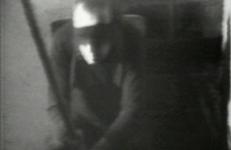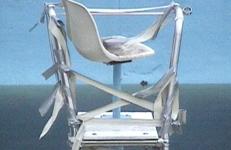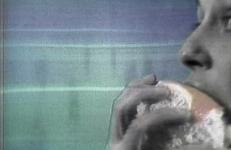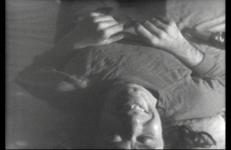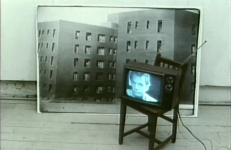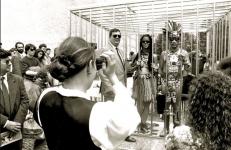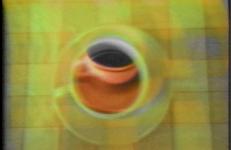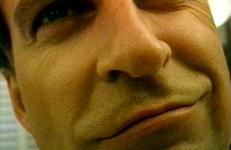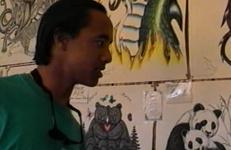"In this record of a live performance, Acconci gives physical manifestation to the subterranean regions of the artist’s mind and will, revealing the effort he must make as an artist to simultaneously convince himself and his audience. Perhaps no other piece from the early 1970s more thoroughly spells out the psychologized drama engendered by performance-based video....
Performance
This video is staged as a reading of the great Soviet poet Vladimir Mayakovsky's famous poem A Cloud in Trousers, written 1914-15. It was an attempt to go beyond the autobiographical mode of Fast Trip, Long Drop by appropriating the allegorical potential of another artist's work. Mayakovsky's poem is lyrical and didactic, romantic and materialist.
C.L.U.E. (color location ultimate experience), Part 1 is a collaborative video and performance work by artists A.L. Steiner and robbinschilds, with AJ Blandford and Seattle-based band Kinski. Inhabiting the intersection of human movement and architecture, A.L. Steiner and robbinschilds (Sonya Robbins and Layla Childs) present a full-spectrum video, set to a score by rock quartet Kinski.
C.L.U.E. (color location ultimate experience), Part 1 is a collaborative video and performance work by artists A.L. Steiner and robbinschilds, with AJ Blandford and Seattle-based band Kinski. Inhabiting the intersection of human movement and architecture, A.L. Steiner and robbinschilds (Sonya Robbins and Layla Childs) present a full-spectrum video, set to a score by rock quartet Kinski.
From the performance by the same name, by Suzanne Lacy, Julio Morales and Unique Holland, with Kim Batiste, Raul Cabra, Patrick Toebe, David Goldberg, and Anne Maria Hardeman, Oakland, 1998-2000.
"Emptiness: I just watched your latest video, Colchones Individuales (Single Beds), Volume 1: Desolacion, and I wanted to write you about it. Oddly, Single Beds sums up much of what I have been thinking lately. In these times of speed, where everything is propelled forward at an incredibly spiraling rate, it is only in moments of pause, of inertia, that we examine what is occurring to us. Your piece, Single Beds, performs an arrested time, a succinct suspension of time. (It is in many ways a companion piece to an earlier video of yours Staying Alive).
With Cold Harbor, Donigan Cumming uses a minimum of elements to create a powerful anti-war message. Initially, the video seems enigmatic, almost abstract. An amateur Handycam moves tentatively around a hospital room, panning and zooming from the view out the window to the dark-skinned old man lying on the bed. The image is shaky, blurred, often out of focus. Off-screen, a radio or television blares the news.
Three basic compositions are played and recombined in Collage: a hockey game; arms swinging across the screen; and a hand holding one, two, then three oranges. As in her other work, Benglis plays with several generations of each shot, rescanning the screen, and placing objects in front of the monitor. Organized around color and rhythm, each segment uses bright colors, rapid movements, and complex layers of images to present a mesmerizing compendium of information that frustrates any sense of narrative.
Torn over the pressure to perform for his audience, Acconci fantasizes about "a dancing bear" who takes his place, performing in the spotlight, doing what others want, "what I always had to do." The viewer is placed in the position of an authority or analyst, above Acconci’s head, listening to his hallucination. This fantasy becomes increasingly erotic as Acconci unburdens himself psychologically and reveals his contradictory need to control and to be controlled.
This title was in the original Castelli-Sonnabend video art collection.
... part Bronx reminiscence, part landscape fantasy; part morality play, part melodrama. A film in many parts with monologue segments written by James Strahs for Willem Dafoe, Spalding Gray, Ron Vawter, Peyton Smith and Luche Sacker.
Featuring actors from the Wooster Group.
–– Ken Kobland
Compromise is Episode 1 of the video art trilogy, This is More Than Love I Feel Inside, in which Jillian Peña traces a queer relationship from inception to demise.
Stephen Varble (1946-1984) staged gender-confounding costume performances on the streets of 1970s Manhattan, and he became infamous for his anti-commercial disruptions of galleries, banks, and boutiques. In 1978, he retreated from this public work to focus on the making of an epic, unfinished piece of video art, Journey to the Sun, until his death in the first days of 1984. Lush, ribald, and unorthodox, the video mixed non-narrative costume performances with a surrealist fable of a messianic martyr, the Warbler.
In a series of 1992 performances, Coco Fusco and performance co-creator Guillermo Gómez-Peña decked themselves out in primitive costumes and appeared before the public as “undiscovered AmerIndians” locked in a golden cage — an exercise in faux anthropology based on racist images of natives. Presented eight times in four different countries, these simple performances evoked various responses, the most startling being the huge numbers of people who didn’t find the idea of “natives” locked in a cage objectionable.
In a series of 1992 performances, Coco Fusco and performance co-creator Guillermo Gómez-Peña decked themselves out in primitive costumes and appeared before the public as “undiscovered AmerIndians” locked in a golden cage — an exercise in faux anthropology based on racist images of natives. Presented eight times in four different countries, these simple performances evoked various responses, the most startling being the huge numbers of people who didn’t find the idea of “natives” locked in a cage objectionable.
“The idea was to address the cultural invisibility of older women through art and through action,” the voice-over explains as this video begins. This short works offers an introduction to the Whisper Minnesota Project, which organized The Crystal Quilt performance, an event that brought together hundreds of women over 60 on a Mother’s Day in Minneapolis. As the video explains, “The Crystal Quilt is a case study in reframing notions of older women’s beauty, power, and relevance. Through it we catch glimpses of life patterns and values lost to our generation.”
"A cup and saucer, pouring and drinking coffee, a duration ritual of contemplation and invigoration, doubled (tape copied), mixed, keyed + synthetic color, normal play and rewinding, sync events, the opening of a space to put the self in. 1/2 inch b+w Portapack, 2 reel to reel video tape decks, David Jones keyer and colorizer."
– Peer Bode
In this video, the unseen narrator describes her inability to communicate to the camera what she wants to say and to whom she wants to say it. The curtain is the central metaphor for the piece, representing how Latham hides behind the video medium, as well as how the medium presents an obstacle to the artist, functioning as a cumbersome intermediary to expression.
This title is also available on Barbara Latham Videoworks: Volume 1.
The police phoned. They left a message on the machine. They said he was dead. The video unwinds through stories of sex for rent, unclaimed bodies, cigarette burns, and other monuments of life’s long run from wall to wall. Cut the Parrot is three grotesque comedies in one: the stories of Gerry, Susan, and Albert. Songs of hope and heartbreak spill from the mouths of the performers. The order of impersonation rules.
Eiko & Koma created Dancing in Water: the Making of River as the first video work for the Retrospective Project. Often produced in collaboration with environmental groups and park officials, River is an outdoor work Eiko & Koma performed in nine different sites. River usually takes place in a body of moving water, and the journey downstream suggests the passage of life and time. This video follows Eiko & Koma from rehearsals in the Catskills to performances in the Delaware River and the American Dance Festival.
Riffing on relations between grief, love, bodies, and embodiment, this short film features two former professional Ringling Bros. and Barnum & Bailey Circus clowns. A Dark Love Story for Clowns weaves together a loosely adapted William Faulkner story with a spiritual ritualistic practice in order to explore the performativity around ethics of care and love.
In this interview, American artist, independent curator, writer, and experimental filmmaker, Vaginal Davis reflects on her initiation into the punk rock and art scenes of Los Angeles during the 1980s and 90s, her stylistic influences, and her ongoing efforts to theorize queerness and visuality. Caught between the opposing poles of Hollywood classicism and the rawness of punk, Davis defines her unapologetically gender-bending, campy, and at times aggressively critical performances as scenarios, rather than spectacles or entertainment.
This title is only available on Kip Fulbeck Selected Videos: Volume One.
Susan Mogul's fantasies of success have always a comic, congenial twist, as in Dear Dennis, a video letter to Dennis Hopper inspired by her discovery that they share the same dentist. The central irony of this witty piece is that, despite Hopper's popular persona as an innovative, sub-cultural filmmaker and performer, the actual distance between his so-called independent" films and Mogul's experimental, non-commercial videos prevents Susan from finding any common ground from which to address Hopper other than the subject of dental work.
Co-commissioned by the Dance Center of Columbia College Chicago and Danspace Project, Death Poem is a meditation on dying. Eiko dances a long solo on a futon under a mosquito net, accompanied by the sound of insects and cicadas. Koma enters from another world and tries to bring Eiko back with him, but he leaves without her, as she is not yet ready to go.
As a "Post-Mexican” performance artist operating out of the US for over 20 years, one of my conceptual obsessions has been to constantly reposition myself within the hegemonic maps. Whether this map is the Americas, the larger cartography of art, or my personal biography, one of my jobs has been to move around, cross dangerous borders, disappear and reappear somewhere else, and in the process create "imaginary cartographies” capable of containing the complexities of my multiple and ever-changing identities, voices, communities and performative bodies.




